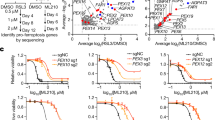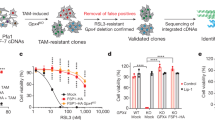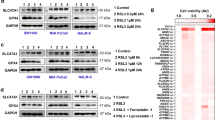Abstract
Ferroptosis is widely involved in degenerative diseases in various tissues including kidney, liver and brain, and is a targetable vulnerability in multiple primary and therapy-resistant cancers. Accumulation of phospholipid hydroperoxides in cellular membranes is the hallmark and rate-limiting step of ferroptosis; however, the enzymes contributing to lipid peroxidation remain poorly characterized. Using genome-wide, CRISPR–Cas9-mediated suppressor screens, we identify cytochrome P450 oxidoreductase (POR) as necessary for ferroptotic cell death in cancer cells exhibiting inherent and induced susceptibility to ferroptosis. By genetic depletion of POR in cancer cells, we reveal that POR contributes to ferroptosis across a wide range of lineages and cell states, and in response to distinct mechanisms of ferroptosis induction. Using systematic lipidomic profiling, we further map POR’s activity to the lipid peroxidation step in ferroptosis. Hence, our work suggests that POR is a key mediator of ferroptosis and potential druggable target for developing antiferroptosis therapeutics.
This is a preview of subscription content, access via your institution
Access options
Access Nature and 54 other Nature Portfolio journals
Get Nature+, our best-value online-access subscription
$29.99 / 30 days
cancel any time
Subscribe to this journal
Receive 12 print issues and online access
$259.00 per year
only $21.58 per issue
Buy this article
- Purchase on Springer Link
- Instant access to full article PDF
Prices may be subject to local taxes which are calculated during checkout





Similar content being viewed by others
Data availability
Raw sequencing data for CRISPR–Cas9 screens in UACC-257 melanoma cells are deposited at the Gene Expression Omnibus (accession number GSE130982). Processed CRISPR screening data are supplied as Supplementary Dataset 1. The global lipidomics analysis results are presented in Supplementary Dataset 2, and the redox-lipidomics analysis results are presented in Supplementary Dataset 3. All original data that support the findings of this study are available upon request.
Code availability
All computational code that support the findings of this study are available upon request.
Change history
02 March 2021
A Correction to this paper has been published: https://doi.org/10.1038/s41589-021-00767-w
References
Viswanathan, V. S. et al. Dependency of a therapy-resistant state of cancer cells on a lipid peroxidase pathway. Nature 547, 453–457 (2017).
Wenzel, S. E. et al. PEBP1 wardens ferroptosis by enabling lipoxygenase generation of lipid death signals. Cell 171, 628–641 (2017).
Hangauer, M. J. et al. Drug-tolerant persister cancer cells are vulnerable to GPX4 inhibition. Nature 551, 247–250 (2017).
Alim, I. et al. Selenium drives a transcriptional adaptive program to block ferroptosis and treat stroke. Cell 177, 1262–1279 (2019).
Li, Q. et al. Inhibition of neuronal ferroptosis protects hemorrhagic brain. JCI Insight 2, e90777 (2017).
Yang, W. S. et al. Regulation of ferroptotic cancer cell death by GPX4. Cell 156, 317–331 (2014).
Friedmann Angeli, J. P. et al. Inactivation of the ferroptosis regulator Gpx4 triggers acute renal failure in mice. Nat. Cell Biol. 16, 1180–1191 (2014).
Bogacz, M. & Krauth-Siegel, R. L. Tryparedoxin peroxidase-deficiency commits trypanosomes to ferroptosis-type cell death. eLife 7, e37503 (2018).
Distéfano, A. M. et al. Heat stress induces ferroptosis-like cell death in plants. J. Cell Biol. 216, 463–476 (2017).
Kagan, V. E. et al. Oxidized arachidonic and adrenic PEs navigate cells to ferroptosis. Nat. Chem. Biol. 13, 81–90 (2017).
Conrad, M. & Pratt, D. A. The chemical basis of ferroptosis. Nat. Chem. Biol. 15, 1137–1147 (2019).
Stockwell, B. R. et al. Ferroptosis: a regulated cell death nexus linking metabolism, redox biology, and disease. Cell 171, 273–285 (2017).
Ingold, I. et al. Selenium utilization by GPX4 is required to prevent hydroperoxide-induced ferroptosis. Cell 172, 409–422 (2018).
Ursini, F., Maiorino, M., Valente, M., Ferri, L. & Gregolin, C. Purification from pig liver of a protein which protects liposomes and biomembranes from peroxidative degradation and exhibits glutathione peroxidase activity on phosphatidylcholine hydroperoxides. Biochim. Biophys. Acta 710, 197–211 (1982).
Zou, Y. et al. A GPX4-dependent cancer cell state underlies the clear-cell morphology and confers sensitivity to ferroptosis. Nat. Commun. 10, 1617 (2019).
Eaton, J. K. et al. Targeting a therapy-resistant cancer cell state using masked electrophiles as GPX4 inhibitors. Preprint at bioRxiv https://doi.org/10.1101/376764 (2018).
Yin, H., Xu, L. & Porter, N. A. Free radical lipid peroxidation: mechanisms and analysis. Chem. Rev. 111, 5944–5972 (2011).
Doll, S. et al. FSP1 is a glutathione-independent ferroptosis suppressor. Nature 575, 693–698 (2019).
Bersuker, K. et al. The CoQ oxidoreductase FSP1 acts parallel to GPX4 to inhibit ferroptosis. Nature 575, 688–692 (2019).
Yang, W. S. et al. Peroxidation of polyunsaturated fatty acids by lipoxygenases drives ferroptosis. Proc. Natl Acad. Sci. USA 113, E4966–E4975 (2016).
Kuhn, H., Banthiya, S. & van Leyen, K. Mammalian lipoxygenases and their biological relevance. Biochim. Biophys. Acta 1851, 308–330 (2015).
Shah, R., Shchepinov, M. S. & Pratt, D. A. Resolving the role of lipoxygenases in the initiation and execution of ferroptosis. ACS Cent. Sci. 4, 387–396 (2018).
Doll, S. et al. ACSL4 dictates ferroptosis sensitivity by shaping cellular lipid composition. Nat. Chem. Biol. 13, 91–98 (2017).
Dixon, S. J. et al. Human haploid cell genetics reveals roles for lipid metabolism genes in nonapoptotic cell death. ACS Chem. Biol. 10, 1604–1609 (2015).
Pandey, A. V. & Flück, C. E. NADPH P450 oxidoreductase: structure, function, and pathology of diseases. Pharmacol. Ther. 138, 229–254 (2013).
Foti, R. S. & Dalvie, D. K. Cytochrome P450 and non-cytochrome P450 oxidative metabolism: contributions to the pharmacokinetics, safety, and efficacy of xenobiotics. Drug Metab. Dispos. 44, 1229–1245 (2016).
Veith, A. & Moorthy, B. Role of cytochrome P450s in the generation and metabolism of reactive oxygen species. Curr. Opin. Toxicol. 7, 44–51 (2018).
Riddick, D. S. et al. NADPH–cytochrome P450 oxidoreductase: roles in physiology, pharmacology, and toxicology. Drug Metab. Disposition 41, 12–23 (2013).
Zilka, O. et al. On the mechanism of cytoprotection by ferrostatin-1 and liproxstatin-1 and the role of lipid peroxidation in ferroptotic cell death. ACS Cent. Sci. 3, 232–243 (2017).
Carithers, L. J. & Moore, H. M. The Genotype-Tissue Expression (GTEx) Project. Biopreserv. Biobank. 13, 307–308 (2015).
Gao, J. et al. Integrative analysis of complex cancer genomics and clinical profiles using the cBioPortal. Sci. Signal. 6, l1 (2013).
Tsherniak, A. et al. Defining a cancer dependency map. Cell 170, 564–576 (2017).
Dixon, S. J. et al. Ferroptosis: an iron-dependent form of nonapoptotic cell death. Cell 149, 1060–1072 (2012).
Shimada, K. et al. Global survey of cell death mechanisms reveals metabolic regulation of ferroptosis. Nat. Chem. Biol. 12, 497–503 (2016).
Griffith, O. W. & Meister, A. Potent and specific inhibition of glutathione synthesis by buthionine sulfoximine (S-n-butyl homocysteine sulfoximine). J. Biol. Chem. 254, 7558–7560 (1979).
Gaschler, M. M. et al. FINO initiates ferroptosis through GPX4 inactivation and iron oxidation. Nat. Chem. Biol. 14, 507–515 (2018).
Ilan, Z., Ilan, R. & Cinti, D. L. Evidence for a new physiological role of hepatic NADPH:ferricytochrome (P-450) oxidoreductase. Direct electron input to the microsomal fatty acid chain elongation system. J. Biol. Chem. 256, 10066–10072 (1981).
Lamb, D. C., Warrilow, A. G., Venkateswarlu, K., Kelly, D. E. & Kelly, S. L. Activities and kinetic mechanisms of native and soluble NADPH-cytochrome P450 reductase. Biochem. Biophys. Res. Commun. 286, 48–54 (2001).
Dixon, S. J. et al. Human haploid cell genetics reveals roles for lipid metabolism genes in nonapoptotic cell death. ACS Chem. Biol. 10, 1604–1609 (2015).
Minoda, Y. & Kharasch, E. D. Halothane-dependent lipid peroxidation in human liver microsomes is catalyzed by cytochrome P4502A6 (CYP2A6). Anesthesiology 95, 509–514 (2001).
Ghosh, M. K., Mukhopadhyay, M. & Chatterjee, I. B. NADPH-initiated cytochrome P450-dependent free iron-independent microsomal lipid peroxidation: specific prevention by ascorbic acid. Mol. Cell. Biochem 166, 35–44 (1997).
Dey, A., Parmar, D., Dhawan, A., Dash, D. & Seth, P. K. Cytochrome P450 2E1 dependent catalytic activity and lipid peroxidation in rat blood lymphocytes. Life Sci. 71, 2509–2519 (2002).
Ghandi, M. et al. Next-generation characterization of the Cancer Cell Line Encyclopedia. Nature 569, 503–508 (2019).
Bast, A., Brenninkmeijer, J. W., Savenije-Chapel, E.M. & Noordhoek, J. Cytochrome P450 oxidase activity and its role in NADPH dependent lipid peroxidation. FEBS Lett. 151, 185–188 (1983).
Sevanian, A., Nordenbrand, K., Kim, E., Ernster, L. & Hochstein, P. Microsomal lipid peroxidation: the role of NADPH–cytochrome P450 reductase and cytochrome P450. Free Radic. Biol. Med. 8, 145–152 (1990).
Ursini, F., Maiorino, M., Hochstein, P. & Ernster, L. Microsomal lipid peroxidation: mechanisms of initiation. The role of iron chelators. Free Radic. Biol. Med. 6, 31–36 (1989).
Girotti, A. W. Lipid hydroperoxide generation, turnover, and effector action in biological systems. J. Lipid Res. 39, 1529–1542 (1998).
Brütsch, S. H. et al. Expression of inactive glutathione peroxidase 4 leads to embryonic lethality, and inactivation of the Alox15 gene does not rescue such knock-in mice. Antioxid. Redox Signal. 22, 281–293 (2015).
Bai, Y.-T. et al. ENPP2 protects cardiomyocytes from erastin-induced ferroptosis. Biochem. Biophys. Res. Commun. 499, 44–51 (2018).
NaveenKumar, S. K. et al. The role of reactive oxygen species and ferroptosis in heme-mediated activation of human platelets. ACS Chem. Biol. 13, 1996–2002 (2018).
Hannah, V. C., Ou, J., Luong, A., Goldstein, J. L. & Brown, M. S. Unsaturated fatty acids down-regulate srebp isoforms 1a and 1c by two mechanisms in HEK-293 cells. J. Biol. Chem. 276, 4365–4372 (2001).
Doench, J. G. et al. Optimized sgRNA design to maximize activity and minimize off-target effects of CRISPR–Cas9. Nat. Biotechnol. 34, 184–191 (2016).
Hegde, M., Strand, C., Hanna, R. E. & Doench, J. G. Uncoupling of sgRNAs from their associated barcodes during PCR amplification of combinatorial CRISPR screens. PLoS ONE 13, e0197547 (2018).
Najm, F. J. et al. Orthologous CRISPR–Cas9 enzymes for combinatorial genetic screens. Nat. Biotechnol. 36, 179–189 (2018).
Sanson, K. R. et al. Optimized libraries for CRISPR–Cas9 genetic screens with multiple modalities. Nat. Commun. 9, 5416 (2018).
Naguib, Y. M. A fluorometric method for measurement of peroxyl radical scavenging activities of lipophilic antioxidants. Anal. Biochem. 265, 290–298 (1998).
Cathcart, R., Schwiers, E. & Ames, B. N. Detection of picomole levels of hydroperoxides using a fluorescent dichlorofluorescein assay. Anal. Biochem. 134, 111–116 (1983).
Wang, W. et al. CD8 + T cells regulate tumour ferroptosis during cancer immunotherapy. Nature 569, 270–274 (2019).
Acknowledgements
We thank R. Aoyagi, M. Arita, P. Kennedy, M. Gijón and T. Zhao for assisting with the redox-lipidomics analyses. This work was supported in part by the NCI’s Cancer Target Discovery and Development (CTD2) Network (grant No. U01CA217848, awarded to S.L.S.), and in part by the National Institute of General Medical Sciences (grant No. R35GM127045, awarded to S.L.S.). G.S.-G. is supported by a fellowship from the Howard Hughes Medical Institute Exceptional Research Opportunities Program.
Author information
Authors and Affiliations
Contributions
Y.Z. and S.L.S. conceived the project and wrote the manuscript. Y.Z. and H.L. designed and performed the experiments and data analyses. H.L. and J.G.D. performed the CRISPR screens in UACC-257 cells. A.A.D. and C.B.C. performed the lipidomics analysis. J.K.E. performed chemical synthesis, as well as the GPX4 and ML210/RSL3 interaction analysis. W.W. assisted the chemical treatment experiments and data interpretations. E.T.G. and G.S-G. assisted the cellular experiments. All authors interpreted data, discussed results and contributed to writing the manuscript.
Corresponding authors
Ethics declarations
Competing interests
S.L.S. serves on the Board of Directors of the Genomics Institute of the Novartis Research Foundation (GNF); is a shareholder and serves on the Board of Directors of Jnana Therapeutics; is a shareholder of Forma Therapeutics; is a shareholder and advises Decibel Therapeutics and Eikonizo Therapeutics; serves on the Scientific Advisory Boards of Eisai Co., Ltd., Ono Pharma Foundation, Exo Therapeutics, and F-Prime Capital Partners; and is a Novartis Faculty Scholar. The remaining authors declare no competing interests.
Additional information
Publisher’s note Springer Nature remains neutral with regard to jurisdictional claims in published maps and institutional affiliations.
Supplementary information
Supplementary Information
Supplementary Figs. 1–10.
Supplementary Dataset 1
Top hits from genome-wide CRISPR screening in UACC-257-Cas9 cells treated with ML210 and linoleic acid (LA, C18:2), α-linolenic acid (ALA, C18:3), arachidonic acid (AA, C20:4), eicosapentaenoic acid (EPA, C20:5), docosapentaenoic acid (DPA, C22:5n-3) or docosahexaenoic acid (DHA, C22:6).
Supplementary Dataset 2
Global lipidomics analysis for WT and POR-depleted 786-O-Cas9 and 769-P-Cas9 cells.
Supplementary Dataset 3
Redox-lipidomics analysis for WT and POR-depleted 786-O-Cas9 and 769-P-Cas9 cells.
Rights and permissions
About this article
Cite this article
Zou, Y., Li, H., Graham, E.T. et al. Cytochrome P450 oxidoreductase contributes to phospholipid peroxidation in ferroptosis. Nat Chem Biol 16, 302–309 (2020). https://doi.org/10.1038/s41589-020-0472-6
Received:
Accepted:
Published:
Issue Date:
DOI: https://doi.org/10.1038/s41589-020-0472-6
This article is cited by
-
Harnessing ferroptosis for enhanced sarcoma treatment: mechanisms, progress and prospects
Experimental Hematology & Oncology (2024)
-
Mechanisms controlling cellular and systemic iron homeostasis
Nature Reviews Molecular Cell Biology (2024)
-
Ferroptosis in cancer: From molecular mechanisms to therapeutic strategies
Signal Transduction and Targeted Therapy (2024)
-
The cell biology of ferroptosis
Nature Reviews Molecular Cell Biology (2024)
-
GAS41 modulates ferroptosis by anchoring NRF2 on chromatin
Nature Communications (2024)



